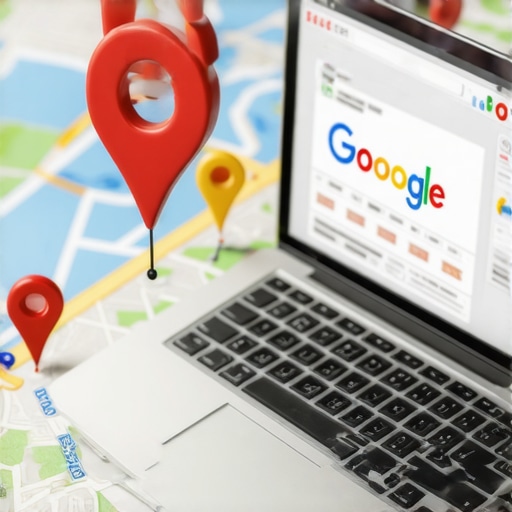Unveiling the Layers of Maps SEO: A Strategic Perspective for 2024
In the rapidly evolving landscape of local search, mastering Maps SEO is no longer optional but essential for businesses aiming for top-tier Google visibility. As an SEO expert with years of field-tested experience, I recognize that optimizing for Google Maps involves a complex interplay of technical finesse, local relevance, and authoritative signals. This article explores advanced tactics that transcend basic optimization, providing a nuanced understanding of how to secure and sustain superior rankings in 2024.
Deciphering the Algorithmic Nuances Behind Google Maps Rankings
Google’s local search algorithm incorporates a myriad of signals, including proximity, relevance, and prominence. Recent studies, such as those documented in reputable sources like Moz’s Local Search Ranking Factors, highlight the increasing importance of semantic relevance and entity authority. Understanding these signals enables marketers to align their strategies with Google’s evolving criteria, leveraging structured data, local citations, and user engagement metrics effectively.
How Do Niche-specific Maps Optimization Tactics Influence Visibility?
Beyond generic practices, niche-specific strategies—such as optimizing service-area businesses (SABs) and multi-location entities—demand meticulous attention to local schema markup, consistent NAP (Name, Address, Phone Number) data, and review management. For instance, implementing advanced local schema enhances contextual relevance, thereby boosting your Google Maps ranking potential.
What Are the Most Overlooked Factors in Maps SEO That Could Be Game Changers?
Many practitioners overlook the significance of Google My Business (GMB) profile health—including consistency in categories, optimized descriptions, and timely review responses. Additionally, leveraging Google Posts and local backlinks can dramatically influence prominence signals, especially in competitive markets. Analyzing competitors’ GMB profiles often reveals opportunities for differentiation that are not immediately apparent.
For a comprehensive understanding of how to elevate your Google Maps presence, explore our Ultimate Maps SEO Guide for 2024.
Engage with this content by sharing your insights or questions in the comments, and stay ahead in the local search game by continuously refining your strategies based on emerging trends and algorithm updates.
Unlocking the Hidden Dimensions of Maps SEO: A Deep Dive into 2024 Strategies
As local search algorithms become increasingly sophisticated, understanding the nuanced signals that influence Google Maps rankings is crucial for maintaining a competitive edge. Beyond basic optimization, advanced tactics such as leveraging entity-based SEO and harnessing the power of local multimedia content can significantly enhance your visibility. These strategies require a nuanced approach, integrating technical, content, and reputation management to create a resilient Maps SEO framework that withstands algorithm shifts.
Can Your Maps SEO Strategy Incorporate the Power of Semantic Entities?
Semantic entities—distinct concepts or objects that Google recognizes as unique—are central to Google’s understanding of relevance. Incorporating structured data that defines your business’s entities, such as services, products, and location-specific attributes, allows Google to better contextualize your listing. Implementing entity-based schema markup enhances your profile’s authority and relevance, especially in highly competitive niches.
How Can Multimedia Content Elevate Your Maps SEO Performance?
Visual content, including high-quality images, virtual tours, and videos, plays a pivotal role in engaging users and boosting your prominence signals. Google increasingly favors listings that offer rich media, as they contribute to higher user engagement and trustworthiness. Embedding optimized images and videos—properly tagged with local keywords—can improve your profile’s attractiveness and click-through rates. For example, a well-optimized virtual tour can persuade potential customers to choose your business over competitors with less engaging profiles.
Furthermore, integrating local keywords naturally into multimedia descriptions can enhance relevance, as highlighted in recent research by Moz, emphasizing the importance of contextually rich content for search visibility.
What Are the Pitfalls of Overlooking Local Backlink Profiles?
Many local SEO practitioners underestimate the influence of a robust backlink profile from reputable local sources. Building relationships with local newspapers, community blogs, and industry associations can generate authoritative backlinks that bolster your Google Maps prominence. These backlinks serve as trust signals, reinforcing your business’s local authority and increasing your chances of ranking higher.
Additionally, maintaining the consistency of your NAP data across all citations and review platforms is vital. Inconsistent information can dilute your local relevance, negatively impacting your rankings.
For a comprehensive approach, consider integrating your local backlink strategy with your overall Maps SEO tactics, ensuring alignment and maximum impact.
Interested in refining your local search presence? Explore our detailed guide on maximizing Google visibility in 2024 and stay ahead of the competition.
Share your thoughts or questions below—what advanced strategies have you found most effective in boosting your Maps SEO? For ongoing insights, consider subscribing to our newsletter or following our latest posts on Maps SEO tips.
Harnessing the Power of Local Semantic Networks for Unparalleled Maps SEO Dominance
In the quest for superior Google Maps rankings, understanding and leveraging the intricate web of semantic relationships within your local ecosystem can be a game-changer. Advanced local SEO practitioners are now focusing on building a robust semantic network—an interconnected web of relevant entities, keywords, and relationships—that signals authority and relevance to Google. This involves meticulous structuring of your website content, schema markup, and local citations to create a cohesive semantic ecosystem that Google can easily interpret and rank highly.
For example, integrating structured data that defines your core services, geographic area, and customer personas helps Google understand the nuanced context of your business. Tools like Google’s Structured Data Markup Helper facilitate embedding rich, entity-specific schema that enhances your profile’s contextual relevance. This strategy, supported by recent research from Moz’s Local Search Ranking Factors, indicates that entity-centric optimization can significantly influence prominence signals, especially in competitive markets.
What are the critical steps to construct an effective local semantic network?
Start by mapping out all relevant entities associated with your business: services, location-specific landmarks, community affiliations, and customer personas. Next, ensure your website, Google My Business profile, and local citations consistently reference these entities with aligned language and keywords. Incorporate schema markup that explicitly defines these relationships, such as LocalBusiness, Service, and Place types, to reinforce your semantic footprint. Regularly update your content to reflect evolving local events or partnerships that further expand your semantic web.
Implementing this layered semantic approach not only bolsters your visibility but also future-proofs your strategy against algorithm updates that increasingly favor contextually rich content. For a comprehensive guide on this approach, explore authoritative resources like Moz’s Semantic SEO for Local Search.
Innovating Visual Engagement: Multimedia as a Signal of Relevance and Trustworthiness
The role of multimedia content in Maps SEO has evolved beyond mere aesthetic appeal into a strategic asset that can influence rankings. High-quality images, 360-degree virtual tours, and localized videos serve as trust signals and engagement boosters, directly impacting your prominence score. Google’s algorithms are increasingly prioritizing listings that demonstrate active user engagement through visual richness, which correlates with higher click-through and conversion rates.
Embedding optimized multimedia—tagged with local keywords and descriptive metadata—can create a compelling narrative that resonates with local audiences. For instance, a comprehensive virtual tour showcasing your storefront, interior, and community involvement provides Google with a wealth of contextual signals while enticing potential customers.
Additionally, leveraging local multimedia content can foster backlinks from local media, blogs, and community platforms, further amplifying your local authority. To maximize these benefits, integrate multimedia content into your Google My Business posts and website using schema-rich descriptions, ensuring search engines recognize their relevance.
How can multimedia content be systematically optimized for local SEO impact?
Begin by conducting keyword research specific to your locale and services to craft descriptive file names and metadata for all multimedia. Use tools like Google’s Image Search to analyze trending visuals and align your content accordingly. Incorporate local landmarks, community events, or customer testimonials within your videos and images to deepen relevance. Regularly update your multimedia assets to reflect seasonal promotions or new offerings, maintaining an active and engaging profile that signals vitality and local prominence.
For more insights on multimedia optimization, see authoritative guidance from Moz’s Visual Content & SEO.
Advance Your Local SEO Strategy: Integrate Data-Driven Backlink Building for Local Authority
While content and schema optimization are vital, the backbone of a formidable Maps SEO campaign remains a robust backlink profile from reputable local sources. Strategic outreach to local newspapers, industry associations, and community blogs can generate high-quality backlinks that serve as trust signals and boost your prominence in local search results.
Implementing local link-building campaigns requires a nuanced understanding of your community’s digital landscape. Focus on creating valuable partnerships, sponsoring local events, or contributing expert content to authoritative local platforms. These efforts not only generate backlinks but also enhance your reputation and visibility within the community.
Consistency is key. Regularly audit your backlink profile with tools like Ahrefs or SEMrush to ensure the quality and relevance of your links, removing any low-quality or spammy links that could harm your rankings. For an in-depth strategic framework, see Moz’s authoritative guide on Local Backlink Strategies for SEO.
If you’re serious about elevating your Maps SEO game, consider conducting a comprehensive audit of your current local presence, identifying gaps, and systematically executing an integrated strategy that combines semantic depth, multimedia engagement, and authoritative backlinking. Want expert guidance tailored to your niche? Reach out to our team for a personalized consultation and unlock the full potential of your local search presence.
Unlocking the Potential of Local Schema: Beyond Basic Markup
While implementing local schema markup is standard practice, the real game-changer lies in leveraging dynamic schema that adapts based on user behavior, seasonal trends, and real-time data. Advanced marketers utilize tools like Google’s Structured Data Markup Helper combined with custom scripts to automate schema updates, ensuring that your listings remain contextually relevant and highly authoritative.
How Can Voice Search Optimization Revolutionize Maps SEO?
With the proliferation of voice-activated devices, optimizing for conversational queries and natural language keywords is paramount. Embedding long-tail, question-based keywords within your GMB profile and website content can significantly improve your chances of appearing in voice search results, which are often location-specific. According to a report by BrightLocal, voice searches account for over 20% of mobile searches, underscoring their importance in local SEO campaigns.
What are the most sophisticated tactics to enhance voice search visibility in local Maps SEO?
Implement structured data that answers common local questions directly, such as “Where is the nearest vegan restaurant with outdoor seating?” Additionally, create FAQ pages targeting voice search queries with precise, succinct answers. Incorporate schema markup for FAQs and Q&A snippets to increase your chances of feature prominence in voice responses.
Can AI-Driven Local Content Personalization Boost Your Maps Rankings?
Emerging AI technologies enable hyper-local content customization based on user preferences, search history, and contextual signals. Integrating AI-powered chatbots on your website and social media platforms can generate personalized recommendations and reviews, fostering higher engagement and trust signals. Google’s algorithms increasingly weigh user engagement metrics, making personalized experiences a strategic advantage.
How Do You Establish a Resilient Reputation Management System in Competitive Markets?
Beyond responding to reviews, sophisticated reputation management involves actively soliciting authentic feedback, leveraging sentiment analysis tools, and engaging with community influencers. Building a network of local advocates and actively managing your online reputation across multiple review platforms creates a formidable authority signal, which Google interprets as a sign of trustworthiness and prominence.
What Role Does Community Engagement Play in Long-Term Maps SEO Success?
Active participation in local events, sponsorships, and partnerships not only enhances community visibility but also generates valuable local backlinks and citations. Creating content around local topics and participating in community discussions can lead to natural mentions and references, further enriching your semantic ecosystem. An integrated approach combining community involvement with content marketing sustains long-term ranking stability in Google Maps.
Ready to Elevate Your Local Search Strategy?
For those committed to mastering the nuances of Maps SEO, continuous innovation is key. Explore cutting-edge techniques like AI personalization, dynamic schema, and voice search optimization to stay ahead of the curve. Reach out to our expert team for tailored strategies that align with your unique local market challenges and opportunities. Elevate your visibility, authority, and customer engagement today!
Expert Insights & Advanced Considerations
1. Emphasize Entity-Centric Optimization
Focusing on semantic entities and structured data enhances Google’s understanding of your local relevance, making your listings more authoritative in competitive markets.
2. Leverage Multimedia as Relevance Signals
Rich visuals like videos and virtual tours not only engage users but also serve as trust signals that can elevate your prominence in local search results.
3. Build Local Backlink Authority Strategically
Target reputable community sources and local partnerships to develop a backlink profile that reinforces your business’s trustworthiness and boosts visibility.
4. Implement Dynamic Schema Markup
Utilize real-time data and seasonal adjustments in schema to keep your listings contextually relevant, improving Google’s ranking signals.
5. Optimize for Voice Search with Conversational Keywords
Integrate long-tail, question-based keywords and FAQ schema to capture voice queries, which are increasingly dominant in local searches.
Curated Expert Resources
- Moz’s Local Search Ranking Factors: Provides in-depth analysis of the signals influencing Google Maps rankings and how to optimize for them.
- Google’s Structured Data Markup Helper: Essential tool for implementing and testing schema markup that enhances local relevance.
- BrightLocal’s Voice Search Optimization Guide: Offers advanced tactics for capturing voice search traffic and increasing local visibility.
- SEMrush Local SEO Toolkit: A comprehensive resource for tracking backlink profiles, citations, and local rankings in real-time.
Final Expert Perspective
Mastering Maps SEO in 2024 requires a sophisticated blend of semantic depth, multimedia engagement, and authoritative backlinking. The most impactful strategies go beyond basics, focusing on dynamic schema, voice search optimization, and local entity networks. These insights position your business at the forefront of local search dominance. For those committed to elevating their visibility, engaging with these advanced tactics and resources is essential. Reach out with your insights or questions—our team is ready to help you implement these cutting-edge strategies effectively and secure your place at the top of local search results in 2024.




Benjamin Wright
This comprehensive article really captures the multifaceted nature of Maps SEO in 2024. I particularly appreciate the emphasis on semantic relevance and the construction of a semantic network, which often gets overlooked. My experience has shown that businesses that invest in defining clear entity relationships across their website and local citations tend to outperform competitors in local rankings. The discussion on multimedia engagement also resonated with me — I’ve seen virtual tours and localized videos greatly increase user engagement and trust, which directly influences prominence. One challenge I often encounter is maintaining a consistent and updated schema markup, especially for multi-location businesses. Does anyone have effective tools or workflows to streamline dynamic schema updates in real-time? I’m curious how others handle this aspect without it becoming overly cumbersome.
Sarah Johnson
This article really hits the mark on how crucial semantic relevance and structured data are becoming in Maps SEO for 2024. I’ve noticed that integrating entity-based schema markup, especially for multi-location businesses, can be quite challenging without the right tools. Personally, I’ve had success using schema management plugins that allow bulk updates and automation, which saves a lot of time and reduces errors. Additionally, staying consistent with NAP data across all citations is something I believe is often overlooked but incredibly impactful. Does anyone have recommendations for real-time schema automation tools or workflows that can adapt dynamically as businesses grow and change? I’d love to hear about methods that help keep schema data fresh without adding a ton of manual work, especially for agencies managing multiple clients.